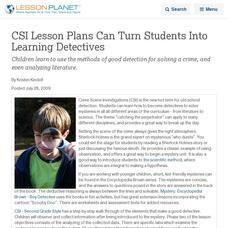Curated OER
Hair Test
In this forensic science worksheet, students write an essay about 3 open response questions presented about hair evidence shown on the photo.
Curated OER
Hair Test
In this forensic science worksheet, students write an open response to 2 questions about a picture of hair evidence collected from the crime scene.
Curated OER
Hair Test
In this forensic science instructional activity, high schoolers write an open response to 1 question on hair evidence photo taken from the crime scene.
Curated OER
A Crime Against Plants
Students research the phenomenon that is living in a small tree. They develop their own conclusion on what they believed is occuring. They answer discussion questions to end the instructional activity.
Curated OER
Who Is It?/Who Done It?
Students conduct an experiment that allows them to assess individual differences in random DNA sequences and apply those differences when solving a forensic problem. After discussing the polymerase chain reaction and its use to identify...
Curated OER
CSI Lesson Plans Can Turn Students Into Learning Detectives
Children learn to use the methods of good detection for solving a crime, and even analyzing literature.
Curated OER
Flipping Coins: Density as a Characteristic Property
Young scholars explore linear functions in a crime solving context. They collect and analyze data using linear equations, then interpret the slope and intercepts from a linear model.
Curated OER
Steller Web Spinning Mystery
Young scholars investigate what a system is in the scientific world. They watch a video of the Stellar seals of Alaska and develop clues as to why the seals are leaving. They discover through the clues they discover, how the components...
Shmoop
ELA - Literacy.CCSS.ELA-Literacy.RST.9-10.6
Key to understanding scientific or technical texts is identifying the underlying question the author is attempting to answer. Provide your young scientists with an opportunity to practice identifying these questions and the procedures...
Curated OER
DNA Fingerprinting
Students discuss methods used by forensic scientists and the basics of DNA and how it can be used to identify an individual after reading an article from The New York Times.
Curated OER
High School Energy Audit
A student-led energy audit of their high school is the focus of this energy lesson. They review the cost of energy in their school, find where it is being wasted, and attempt to cut costs by 10%. A worthy lesson!
Curated OER
Trace Evidence
In this trace evidence worksheet, students use the websites on the forensic science page of the kid zone at http://sciencespot.net/ to complete the fill in the blank questions on the worksheet.
Curated OER
Handwriting and Forgery
Pupils determine how forensics analyze handwriting samples. In this physical science lesson, students research how handwriting analyses help solve their assigned cases. They prepare a skit and present it in class.
Curated OER
Density of Glass Fragments
Young scholars explore how the density of an object is determined and determine what a "physical property" is. They demonstrate how science can be applied to police work.
Curated OER
Blood Analysis
Students reconstruct a crime scene to produce the blood spatter pattern. In this forensic science lesson, students describe the events that lead to produce such patterns. They explain the importance of blood analysis in solving crimes.
Curated OER
The Case of the Disappearing Frogs
Students complete an Internet based activity to investigate the case of the disappearing tadpoles. They discover the interrelationship of living things.
Curated OER
NUMB3RS Activity: Regular Ploygon Centroids
Students investigate geo-profiling. In this secondary mathematics activity, students use geo-profiling to determine the most probable location of a criminal. Students find the centroid of a polygon where the vertices represent crime...
Curated OER
Forensic Examination of Artifacts: The Mystery of Meriwether Lewis' Death
Students role play the position of a scientist to gather information on Meriwether Lewis' death. They discover what he did after the famous expedition and how centuries affect the study of a body. They share their information with the...
Curated OER
Fingerprinting
Students list and describe the three types of fingerprint patterns. They list and describe three layers of fingerprints that can be made. They explain why we leave fingerprints.
Curated OER
Archaeological Detectives
Middle schoolers, in groups, examine in depth one aspect of forensic archaeology to determine the skeleton's age, gender, and possible cause of death. To do so, students must first explain what is involved in each aspect of forensic...
Curated OER
Soil Detectives: The Case of the Lost Friends
Students show how soil varies across the landscape, they explain how soil can be used to solve mysteries. Pupils are introduced to techniques that would be used to distinguish soils from different places.
Curated OER
Introduction to Correlations
Young scholars investigate correlations between human body height and other human features. They select ten subjects and record each subject's age and gender and measure for height, wingspan, distance, and size of hands. After measuring,...
Curated OER
Careers in Chemistry
Students watch a video about careers in chemistry. In this Chemistry lesson plan, students will research chemistry careers and chose one to do further research on.
Curated OER
The Cost of Telling the Truth
Students examine Leopold's Land Ethic involving illegal river dumping. They consider the dilemmas of the case study and share their ideas for a solution using group discussion and individual answers.

























